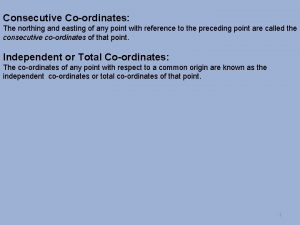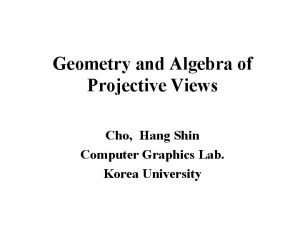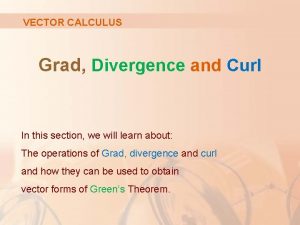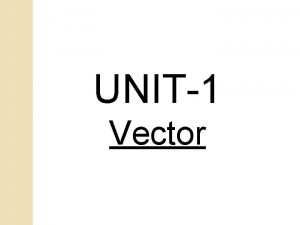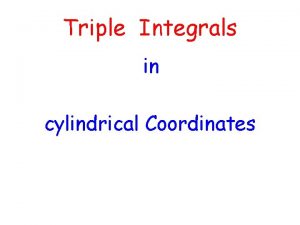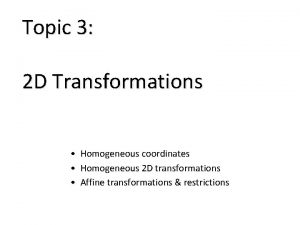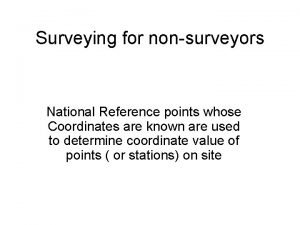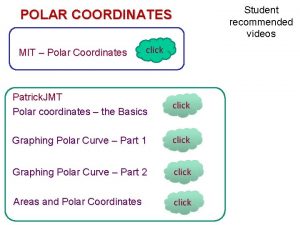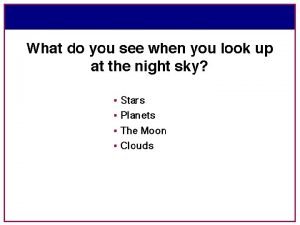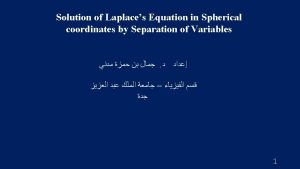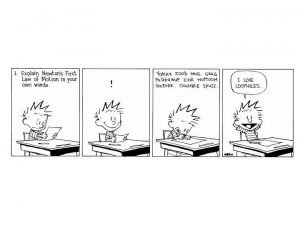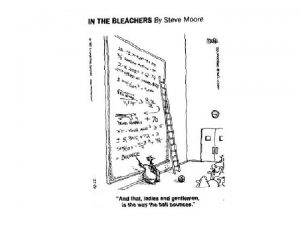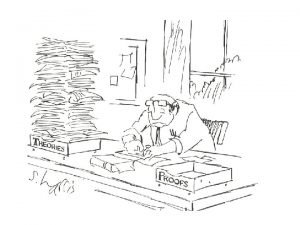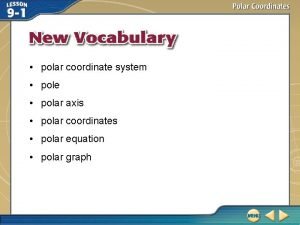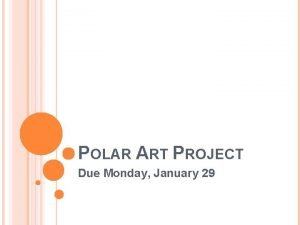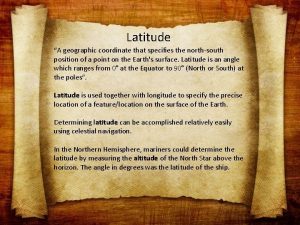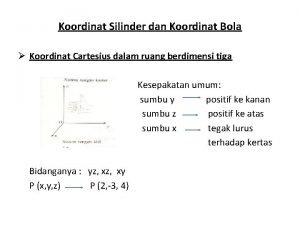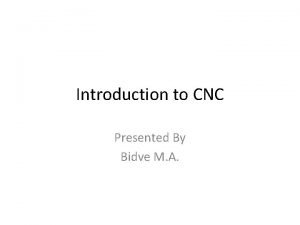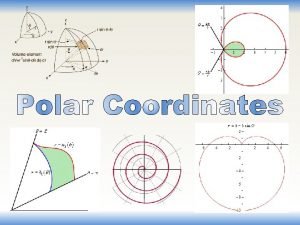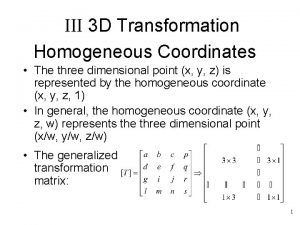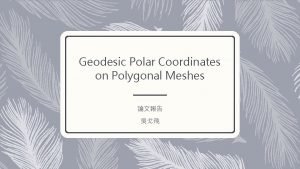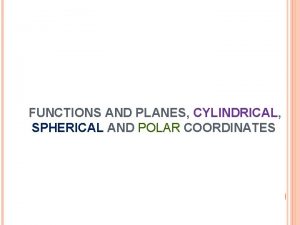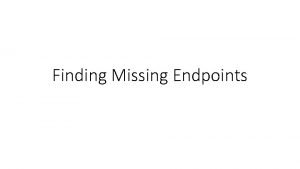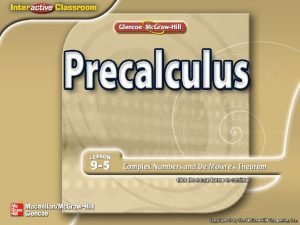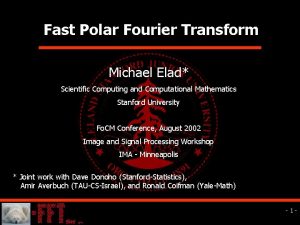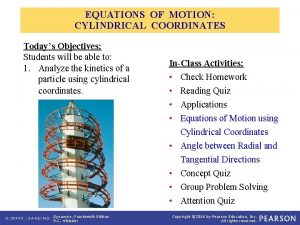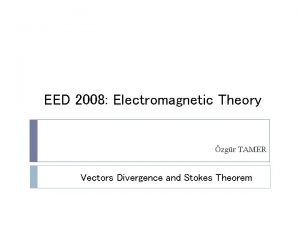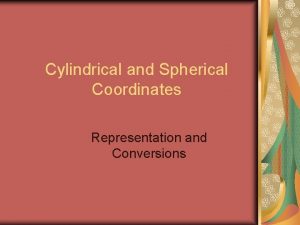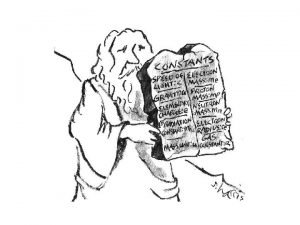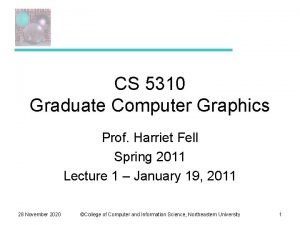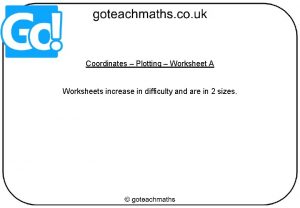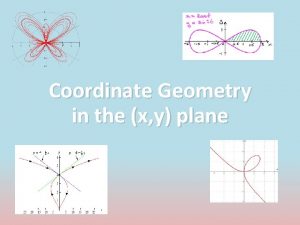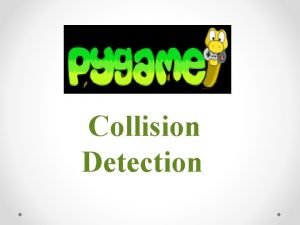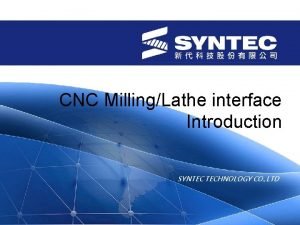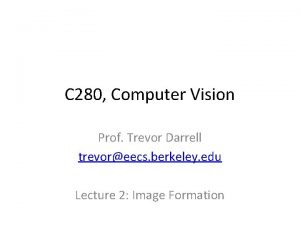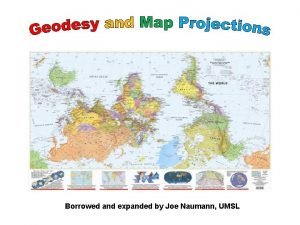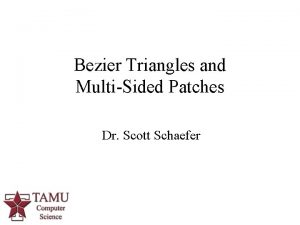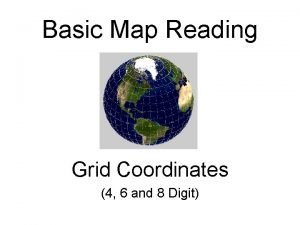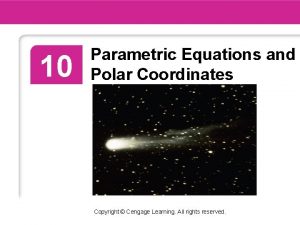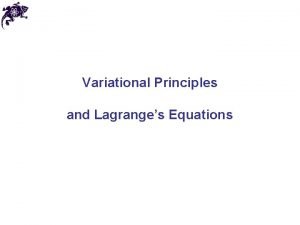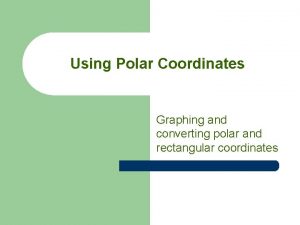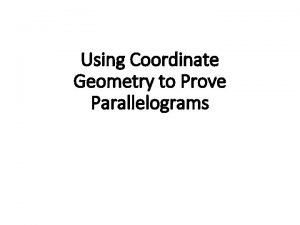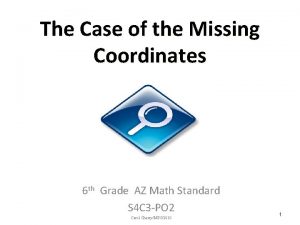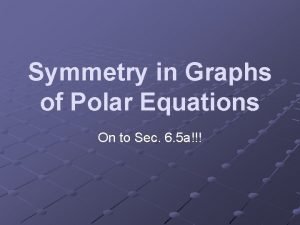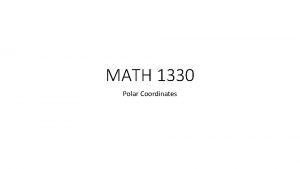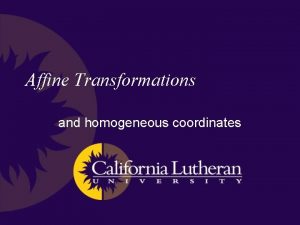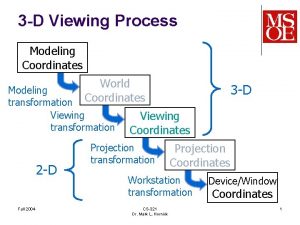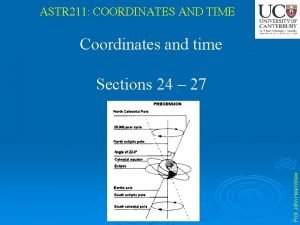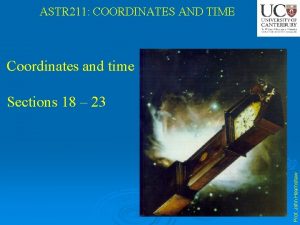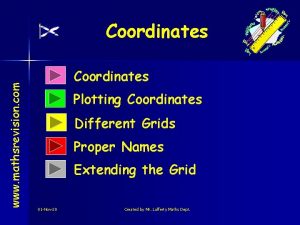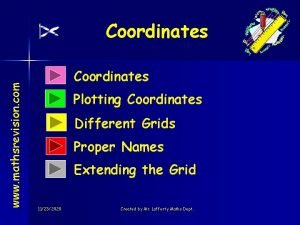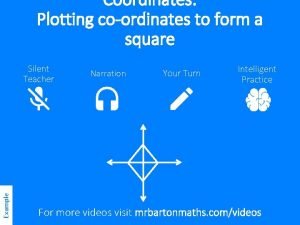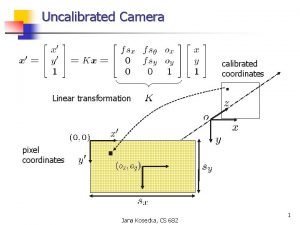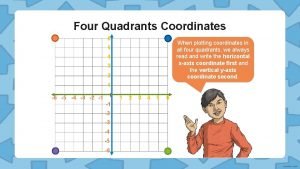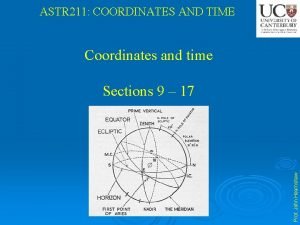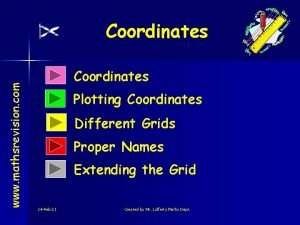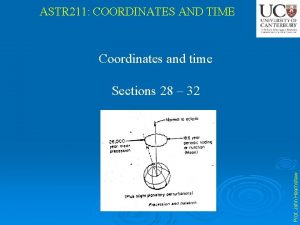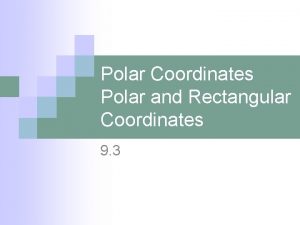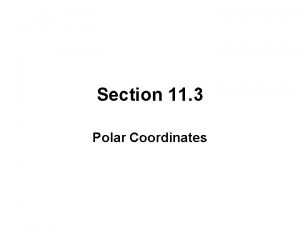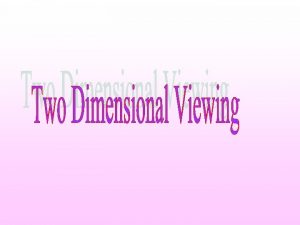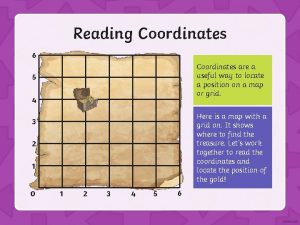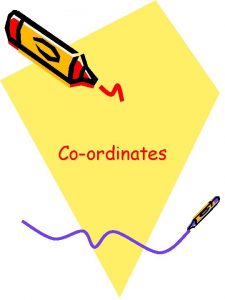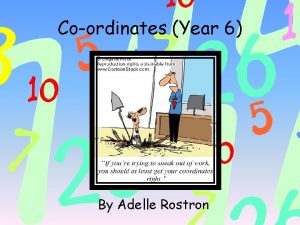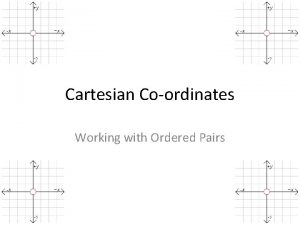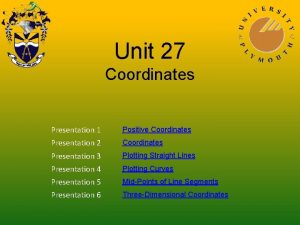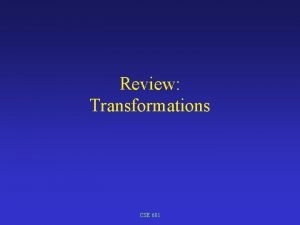2 D Transformations 2 D Transformations World Coordinates















































- Slides: 47

2 D Transformations

2 D Transformations • • World Coordinates Translate Rotate Scale Viewport Transforms Hierarchical Model Transforms Putting it all together

Transformations • Rigid Body Transformations - transformations that do not change the object. • Translate – If you translate a rectangle, it is still a rectangle • Scale – If you scale a rectangle, it is still a rectangle • Rotate – If you rotate a rectangle, it is still a rectangle

Vertices • We have always represented vertices as (x, y) • An alternate method is: • Example:

Matrix * Vector

Matrix * Matrix Does A*B = B*A? NO What does the identity do? AI=A

Translation • Translation - repositioning an object along a straight-line path (the translation distance) from one coordinate location to another. (x’, y’) (tx, ty) (x, y)

Translation • Given: • We want: • Matrix form:


Recall • A point is a position specified with coordinate values in some reference frame. • We usually label a point in this reference point as the origin. • All points in the reference frame are given with respect to the origin.

Applying to Triangles (tx, ty)

What do we have here? • You know how to:

Scale • Scale - Alters the size of an object. • Scales about a fixed point (x’, y’) (x, y)

Scale • Given: • We want: • Matrix form:

Non-Uniform Scale (x’, y’) (x, y) S=(1, 2)

Rotation • Rotation - repositions an object along a circular path. • Rotation requires an and a pivot point

Rotation

Example • P=(4, 4) • =45 degrees

Rotations V(-0. 6, 0) V(0, -0. 6) V(0. 6, 0. 6) Rotate -30 degrees V(0, 0. 6) V(0. 3, 0. 9) V(0, 1. 2)

Combining Transformations Q: How do we specify each transformation?

Specifying 2 D Transformations • Translation – T(tx, ty) – Translation distances • Scale – S(sx, sy) – Scale factors • Rotation – R( ) – Rotation angle

Combining Transformations • Using translate, rotation, and scale, how do we get:

Combining Transformations • Note there are two ways to combine rotation and translation. Why?

Let’s look at the equations

Combining them • We must do each step in turn. First we rotate the points, then we translate, etc. • Since we can represent the transformations by matrices, why don’t we just combine them?

2 x 2 -> 3 x 3 Matrices • We can combine transformations by expanding from 2 x 2 to 3 x 3 matrices.

Homogenous Coordinates • We need to do something to the vertices • By increasing the dimensionality of the problem we can transform the addition component of Translation into multiplication.

Homogenous Coordinates • Homogenous Coordinates - term used in mathematics to refer to the effect of this representation on Cartesian equations. Converting a pt(x, y) and f(x, y)=0 -> (xh, yh, h) then in homogenous equations mean (v*xh, v*yh, v*h) can be factored out. • What you should get: By expressing the transformations with homogenous equations and coordinates, all transformations can be expressed as matrix multiplications.

Final Transformations Compare Equations

Combining Transformations

How would we get:

How would we get:

Coordinate Systems • Object Coordinates • World Coordinates • Eye Coordinates

Object Coordinates

World Coordinates

Screen Coordinates

Coordinate Hierarchy

Let’s reexamine assignment 1

Transformation Hierarchies • (See chapter 10 for details) • For example, a robot arm

Transformation Hierarchies • Let’s examine:

Transformation Hierarchies • What is a better way?

Transformation Hierarchies • What is a better way?

World Coordinates Transformation Hierarchies • We can have transformations be in relation to each other Transformation: Upper Arm -> World Upper Arm Coordinates Transformation: Lower -> Upper Lower Arm Coordinates Transformation: Hand-> Lower Hand Coordinates

Rotation about a Fixed Point Start with identity matrix: C I Move fixed point to origin: C CT Rotate: C CR Move fixed point back: C CT -1 Result: C = TR T – 1 which is backwards – Cp This result is a consequence of doing postmultiplications. Let’s try again. 44 Angel: Interactive Computer Graphics 5 E © Addison-Wesley 2009

Reversing the Order We want C = T – 1 R T so we must do the operations in the following order C I C CT -1 C CR C CT Each operation corresponds to one function call in the program. Note that the last operation specified is the first executed in the program 45 Angel: Interactive Computer Graphics 5 E © Addison-Wesley 2009

Open. GL Example • Rotation about z axis by 30 degrees with a fixed point of (1. 0, 2. 0, 3. 0) gl. Matrix. Mode(GL_MODELVIEW); gl. Load. Identity(); gl. Translatef(1. 0, 2. 0, 3. 0); gl. Rotatef(30. 0, 1. 0); gl. Translatef(-1. 0, -2. 0, -3. 0); gl. Begin(GL_TRIANGLES); . . . • Remember that last transform specified in the program is the first applied 46 Angel: Interactive Computer Graphics 5 E © Addison-Wesley 2009

Matrix Stacks • In many situations we want to save transformation matrices for use later – Traversing hierarchical data structures (Chapter 10) – Avoiding state changes when executing display lists • Open. GL maintains stacks for each type of matrix – Access present type (as set by gl. Matrix. Mode) by gl. Push. Matrix() gl. Pop. Matrix() 47 Angel: Interactive Computer Graphics 5 E © Addison-Wesley 2009
 Consecutive coordinates are also known as
Consecutive coordinates are also known as Cho hang
Cho hang Site:slidetodoc.com
Site:slidetodoc.com Curl formula in spherical coordinates
Curl formula in spherical coordinates Dl cylindrical coordinates
Dl cylindrical coordinates Pixel coordinates
Pixel coordinates Triple integral cylindrical coordinates
Triple integral cylindrical coordinates Homogeneous coordinates
Homogeneous coordinates Partial coordinates surveying
Partial coordinates surveying Pole in polar coordinates
Pole in polar coordinates Sc002 constellation chart
Sc002 constellation chart Laplacian in cylindrical coordinates
Laplacian in cylindrical coordinates Cyclic coordinate definition and examples
Cyclic coordinate definition and examples What are normal coordinates
What are normal coordinates Conservation theorem and symmetry properties
Conservation theorem and symmetry properties Pole in polar coordinates
Pole in polar coordinates Calculator art project
Calculator art project Coordinates that specifies the north-south position.
Coordinates that specifies the north-south position. Koordinat silinder
Koordinat silinder Incremental coordinates
Incremental coordinates Line in polar coordinates
Line in polar coordinates Homogeneous coordinates
Homogeneous coordinates Polar parameterization
Polar parameterization Differential form of amperes law
Differential form of amperes law Cylindrical coordinates grapher
Cylindrical coordinates grapher Find missing endpoint
Find missing endpoint Find rectangular coordinates
Find rectangular coordinates Fourier transform in polar coordinates
Fourier transform in polar coordinates Polar coordinates dynamics examples
Polar coordinates dynamics examples Surface integrals
Surface integrals Distance between pixels is called
Distance between pixels is called Cylindrical spherical coordinates
Cylindrical spherical coordinates Cyclic coordinates in hamiltonian
Cyclic coordinates in hamiltonian Barycentric coordinates
Barycentric coordinates Plotting coordinates worksheets
Plotting coordinates worksheets Xy coordinates
Xy coordinates Pygame coordinates
Pygame coordinates Incremental coordinates
Incremental coordinates Pixel coordinates
Pixel coordinates Where is 0 0 coordinates on earth
Where is 0 0 coordinates on earth Barycentric coordinates
Barycentric coordinates Longitude grid square value on a map
Longitude grid square value on a map Polar curve
Polar curve Joseph-louis lagrange
Joseph-louis lagrange How to add in polar form
How to add in polar form Area of parallelogram using coordinates
Area of parallelogram using coordinates Fill in the missing coordinates
Fill in the missing coordinates Polar coordinate symmetry
Polar coordinate symmetry
